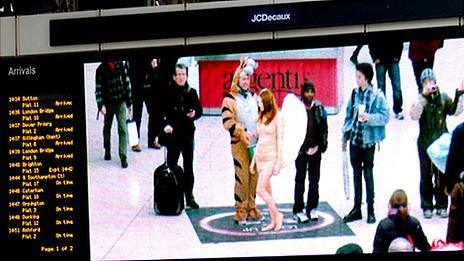Augmented reality goes beyond gimmicks for business
- Published

The people at Lynx cannot help but be pleased with the success of their latest deodorant.
Their new fragrance has emerged as their second-best-selling variant after just a few months on the market, thanks in large part to an innovative advertising campaign.
The campaign was fronted by Kelly Brook posing as a voluptuous fallen angel, but what made it unique was a stunt at London's Victoria Station, known by its orchestrators as Angel Ambush.
Commuters who happened to walk across a particular spot suddenly saw themselves on a vast video screen next to the departures board and, as they watched the screen, they discovered that they were not alone.
An angel, generated using augmented reality technology, fell to earth and appeared to interact with the unsuspecting humans, creating a stir and a viral YouTube clip that has since been viewed more than 750,000 times.
"We didn't know if it would work, either technically or in terms of how people would respond to it," said Becca Sawyer of Mindshare, the advertising agency that came up with the Angel Ambush idea.
"We just thought it would be fantastic if an angel could seem to appear in real-life. Augmented reality is all about creating a fantasy experience that people can interact with."
Although the stunt may have looked cutting edge, it was actually a relatively simple application of augmented reality: a technology that is a capable of more than just stunts.
Hold it, buy it
Some experts have commented that Angel Ambush was not 'real' augmented reality at all, because the virtual angel was just a layer of video manipulated by a human operator, rather than an independent 3D object.
According to Myles Peyton, UK Sales Director at tech firm Total Immersion, the true commercial power of augmented reality lies in its ability to let consumers virtually hold and interact with products that are fully and accurately modelled in the virtual world.
Watch: Myles Peyton demonstrates how augmented reality works
"We know that the longer somebody touches a product, the more likely they are to purchase that product. So by giving them a virtual product, it can drive and uplift sales."
"We're seeing augmented reality move from being a gimmick, to being a trend. It's going to explode", said Mr Peyton.
Total Immersion specialises in so-called web mashups, where an online user sees a video reflection of themselves coupled with a 3D object that they can control, such as camera that responds accurately to button presses, or a pair of glasses that lets the user switch the frame or colour scheme.
Mashups have been around for a while. In 2008, analysts at Gartner recognised them as key to making augmented reality one of its top ten disruptive technologies by 2012.
With that date just around the corner, it is debatable whether augmented reality has lived up to expectations. Nevertheless, Mr Peyton is convinced that the technology has reached a tipping point.
He quotes a more recent forecast from ABI Research that the augmented reality market will be worth $3bn (£1.8bn)by 2016, compared with just $21m in 2010.
The reason for such confidence in augmented reality derives not from major leaps in the technology itself, but from a separate revolution: the emergence of the smartphone.
A small window on another world
Mr Peyton takes out his smartphone and points it at a piece of paper. The paper bears the image of some rough terrain, rather like a satellite photo of Mars, and this image is immediately replicated on the phone's small LCD screen via its built-in camera.
As soon as that happens, a tiny yellow robot appears on the screen and animates, apparently roving around the rough terrain.
The 3D illusion is easily maintained by the phone's processor: the view of the robot changes smoothly and accurately as the phone is moved relative to the piece of paper, revealing different angles, making it look closer or further away, and triggering different behaviours.
This ability to bring life to an inanimate image is what so excites people in marketing and advertising, because exactly the same thing can be applied to a billboard poster or an advert in a newspaper.
A consumer can point their phone at such an image and see a whole new layer of information, designed to connect them to a brand or product and deliver extra information in an engaging way.
There is considerable excitement about mobile augmented reality in other sectors too.
Instruction manual 2.0
Metaio is a Germany-based augmented reality company with a long history of developing industrial applications for clients such as Volkswagen.
In one example, they shot video of an existing car production line in full swing, and then processed virtual 3D components for a new car through that video in order to detect compatibility problems before real-life production even started.
Now, they are looking to bring that level of precision to smartphones, to give businesses a new way of guiding individuals through the use of their products.
"Imagine a service engineer who needs to fix an engine," says Metaio's Jan Schlink.
"He points his smartphone at it, and he sees a 3D model on the screen, guiding him exactly through each stage of the repairs."
The same approach could be used for any type of product, from changing a printer toner cartridge to following a cooking recipe.
"We have a vision that this will become a totally new user interface," says Mr Schlink.
"The smartphone is the catalyst for all of this: holding your phone up to an object and getting rich digital information from the internet that is tightly registered to that object. We say that is a paradigm shift."